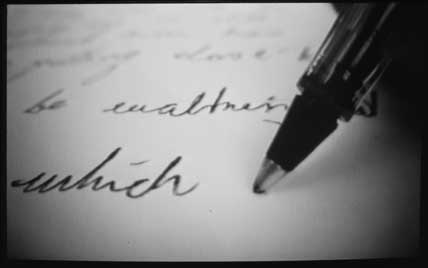| |
The performer sits in a public space. Equipped with video camera, pen and paper he watches and attempts to document his surroundings, in real time, through the act of writing. The video camera records the inscription.
I have always distrusted the camera’s privileged position, the way it collects information unscrupulously, where whatever comes before the lens is recorded. There is no screening procedure; the camera captures all, both foreground background and everything in between. In the writing works I was interested in using the video camera in a way where the captured subject escapes the objectification that comes with being recorded. I wanted to limit the camera’s power to capture. In my mind it was a power that was largely unregulated and unopposed.
In her book On Photography Susan Sontag describes this power as “predatory”. She writes; “To photograph people is to violate them, by seeing them as they never see themselves, by having knowledge of them they can never have; it turns people into objects that can be symbolically possessed” (Sontag, 1984, p. 15).
In order to collaborate with the camera I wanted to forgo or bypass its predatory nature. To achieve this, I situated myself (the performer) as a filter between the actual event and the amended capture (the real time subjective inscription of this event) in an attempt to limit the consuming or predatory nature of the camera.
The resulting collaboration is a highly compromised record, in regards to accuracy, with the camera capturing the subjective act of recording as opposed to the event. Here the camera is muted in its capacity to replicate the scene and to consume the identity of those described, there is no definite identity recorded, no face to pause and study, no body to observe and imagine a past and future for. The camera, although located on site, is turned onto its user who in turn becomes the generator of content. In essence the performer attempts to function as a video camera and to document what he sees before him.
There is a struggle present as language is used to describe the ever-changing visual scene before the performer. Information is compromised firstly through choice of subject, where the performer must select what to note, and in doing so, omit other possibilities that co-exist in the same temporal plane. A subconscious hierarchy eventuates in what is inscribed and what remains unwritten, where the act of recording also becomes an act of exclusion.
Information is also compromised through the choice of language used to describe the dynamic surroundings. I use the word choice loosely as in this case the selection of words is largely dictated by time (as opposed to language selected for its descriptive qualities or its perceived accuracy in relaying the unfolding scene to the reader). The language dictated by time ensures the performer does not have the opportunity to carefully compose sentences due to the fast moving, ever changing nature of what is to be recorded. The more time spent on selecting the appropriate words and phrases, the more information is lost.
Furthermore, language dictated by time also allows for an insight into the history of the narrator, where word choice and grammar become signifiers for the socio-economic standing, ethnicity and education of the performer. In effect, language dictated by time may divulge equally as much about the performer as about the surroundings he is attempting to describe. Hence the introduction of an obvious subjectivity, to maintain the anonymity of those recorded, results in an erosion of the subject’s (performer’s) anonymity. Unable to obtain its pound of flesh from the mediated scene, the camera claims it from the mediator itself. The attempt to evade the camera’s pathology proves futile.
|
|

|